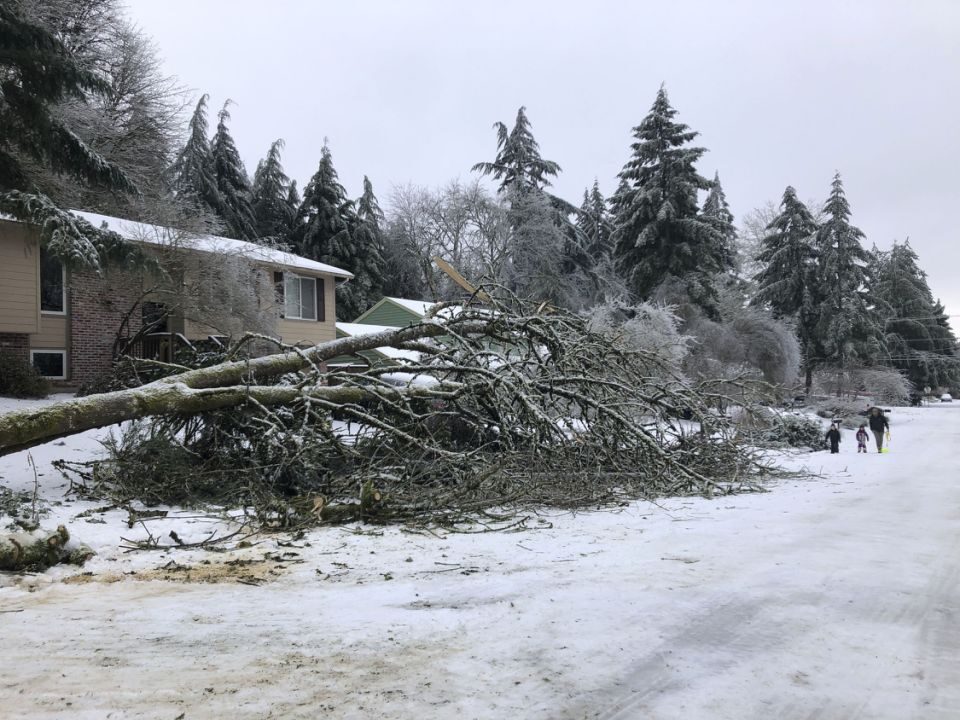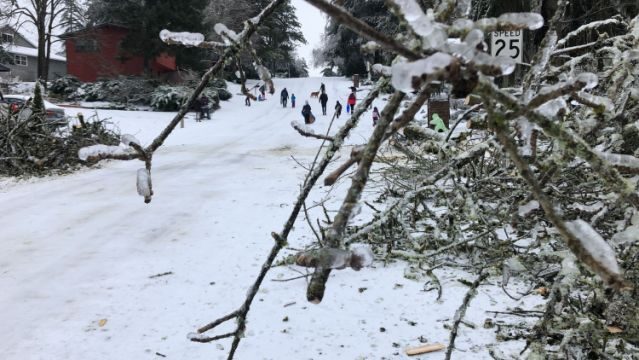
Freezing rain left roads, power lines and trees coated in ice in the Portland, Oregon, region, and by Saturday morning more than 270,000 had lost power. The extreme conditions, loss of power and transportation problems prompted Oregon governor Kate Brown to declare a state of emergency.
"Crews are out in full force now and are coordinating with local emergency response teams on communications for emergency services, such as warming centers," Brown said. "I'm committed to making state resources available to ensure crews have the resources they need on the ground."
Winter storms and extreme cold affected much of the western US, particularly endangering homeless communities. Volunteers and shelter staffers were trying to ensure homeless residents in Casper, Wyoming, were indoors as the National Weather Service (NWS) warned of wind chill reaching as much as -35F (-37C). Authorities in western Washington and western Oregon opened warming shelters in an effort to protect homeless residents from the wet and cold.

"In storms like these, restoration takes time given all of the challenges our crews face in getting to restoration sites and repairing those outages," Lattanner said. "We have more than 600 PGE and contract personnel responding to the storm - it's all hands on deck."
Many ice-laden trees fell on power lines and caused transformers to blow in showers of blue and orange sparks. By noon, more than 1,200 PGE power lines were down, Lattanner said.
The ice and snow caused treacherous driving conditions, forcing Oregon officials to close Interstate 84 in the Columbia River Gorge, and the regional transit agency TriMet suspended all bus and train service in the region. TriMet spokesperson Tia York asked people to avoid all travel unless it's an emergency.
Police in Salem, Oregon, warned residents in Marion and Polk counties to watch for downed power lines and falling tree limbs, and Oregon state police said fallen trees blocked several roads across the region.
In Washington state, snow fell throughout the Seattle region on Saturday morning and freezing rain fell along the coast in Grays Harbor county. The city of Seattle activated its Emergency Operations Center.
Heavy snowfall led to dangerous driving conditions in parts of eastern Oregon and south-western Idaho, with Malheur county, Oregon and Boise, Idaho expected to get as much as 6in.
The NWS said all three states should brace for another surge of winter moisture to hit on Sunday night, potentially leading to more heavy snowfall through Monday. The "unsettled winter conditions" would likely continue throughout the week.
Western Washington was expected to get another 2in possible on Sunday and Monday. Rain falling on snow raised the possibility of urban flooding on Sunday night or Monday in some areas, according to the NWS.
The heavy snow made for dangerous conditions in the many areas across the Olympics and Cascades mountain ranges, with large avalanches possible. Officials with the Payette Avalanche Center in west-central Idaho also warned of increasing avalanche risk.
Idaho's neighbors to the east were blasted by brutally frigid weather, with the NWS warning of dangerous wind chills in Montana and Wyoming. The wind chills were expected to reach as low as -50F in Billings and near Missoula, Montana, and nearly as low across parts of Wyoming.
Wind chills that low can cause frostbite on exposed skin in minutes. The bitter cold was expected to last throughout the weekend. The NWS warned that the wind chill could be dangerous for pets and young livestock, at a time when calving season is beginning for many cattle ranchers.
The Colorado Avalanche Information Center warned of dangerous avalanche conditions in zones around Aspen, Steamboat and Flat Tops, Grand Mesa and Gunnison. Frigid temperatures with lows below zero were expected through Monday morning in Denver and across the Colorado plains.
Source: AP



I live right ON the coast and we were getting freezing rain and had snow for the full day stick to the ground.
When that happens here, you know 100% that inland is a wreck. I actually had people come out from Tacoma to buy my RV and they drove in this crap! They said it was just plain nasty. Trees down every half mile or so, one lane snow cleared, ice everywhere. But....they bought the RV so I am a lil closer to getting the hell out of the crazy ass NW coast. FL soon man! Can't happen soon enough. SO sick of it here.